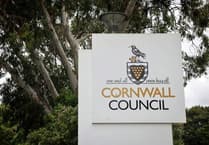Winding down the steep Tamar Valley, the first houses of Harrowbarrow lead one by one into the village proper.
Nestling further down in the valley and separated by old engine houses is the twin village of Metherell.
Rows of miners cottages are testament to the community's place in the mining boom of the 1800s - copper, tin, arsenic, silver and lead were all mined here.
As the century progressed the population exploded and the buildings, known as 'drys' sprung up. There was much overcrowding: we were shown how one row of five dwellings once housed 10 families - the staircase of each one up one down cottage would be visible through the window.
With the influx of miners and their families, three churches were built, and the school showed an attendance of 226 pupils.
Following the demise in mining at the turn of the 20th Century, some sought mining work abroad. Others stayed on to make their living in agriculture or market gardening. Enterprising smallholders turned to the production of soft fruits, cherries and apples, or daffodils, which were first taken by barge to the pannier markets of Plymouth and Devonport, later to markets further upcountry by rail.
Several factors combined to bring about market gardening's decline: red-core disease wiped out several years' harvest of strawberries, the land that was given over to wartime production of vegetables never went back to flowers and, in the end, new methods in cultivation which made growing daffodils on flat ground so much more economical than the hard manual labour that the Tamar Valley's steep fields necessitated.
However the geographical position of the communities was also their salvation. The Tamar Bridge opened in 1962 and land was released for private dwellings - commuters to Tavistock and Plymouth moved in with their families, and the school, which almost closed after World War II, again swelled in numbers. Unlike other villages when traditional industries died out, Harrowbarrow and Metherell have retained a mixed community of young and old, and local businesses continue to thrive.
Committed
Down a steep and narrow lane off the road into Harrowbarrow, Ash House has witnessed the communities' changing fortunes. Once the mining captain's house, it was later the site of a smallholding. Today it is the home of Fred and Mary Davis, who after nearly 50 years in the village still describe themselves modestly as 'newcomers'.
'We came here at Christmas 1950,' said Mary, 'and when we first came we lived in a little cottage, next door to the most lovely family who explained all the local history to us and took us on holiday. We found people so welcoming and kind, it's a privilege to live here.'
Like so many others in the village, Mary and Fred are active in community organisations.
Mary gave us a list of what goes on and the people that take part and it was clear that villagers truly do take pride in their organisations and are committed to keeping them going.
A bi-monthly newsletter, Hamlet, contains listings of meetings and local events, and readers' contributions. Fred told us how a printer based in Metherell used to support the publication - now he has retired the community association makes up the shortfall in funds raised to maintain the newsletter, delivered free to every resident by volunteers.
As we sat in the Davis' lounge a regular visitor appeared at the window - 'Stumpy' the one legged blackbird has his own column in Hamlet and pays visits to several houses for his favourite snack, garibaldi biscuits.
Mary explained that groups have long existed jointly between Harrowbarrow and Metherell, but that the construction of the village hall really brought all these activities together.
Up the hill in Rising Sun, Rex Snuggs showed us a souvenir edition of Hamlet, which came out to celebrate the golden anniversary of the original village memorial institute in the 1920s.
Photos show the old ex-army hut which was purchased by residents - its siting stipulated 'no alcohol and no dancing', but the building was still the hub of community life back then, hosting concerts and political meetings. In later years it was less used, but the Jubilee celebrations in 1977 became the focus for renewed joint activity and the villagers of Harrowbarrow and Metherell, now much larger in number, began to discuss plans for a new hall. A community association was formed in 1981 and finally in 1995, the hall was unveiled.
All the villagers we spoke to paid tribute to Wesley Wilton, who in the words of one was the real 'mover and shaker' in getting the hall off the ground. Wesley's involvements in village activities are too numerous to mention, but others described how he always has time to help out at everything - and a plaque in the hall recognises his efforts.
Prizes
The building is now used for a variety of meetings and activities from tea dances to Tai Chi, school PE lessons and senior citizens' lunches. The rainbow 200 club, run by Rex Snuggs, is a weekly and monthly lottery with prizes of £10 and £50, originally established to raise money for the hall's construction it continues as a source of funds for maintenance. Rex praised the generosity of villagers in their support of charity events - he and his partner Jenny Gale recently held an 'all-day breakfast' at their house and served up £400-worth of healthy breakfasts between 7.30am and 9pm. Their garden will be one of 12 visited by those on a 'garden crawl' organised by the WI at the end of this month in aid of Macmillan Cancer Relief.
Final stop on the garden crawl is Rising Sun Nurseries, owned by the Elias family, who have built it up gradually over their 40 years in the village. It now has an extensive range of mostly bedding plants and shrubs and its own coffee shop.
Employee Catherine Startup, 22, told us about living in Harrowbarrow: 'It can be a bit boring for youngsters but it's a nice place to live. There's not a lot going on, but if I want to go out, I go to Plymouth.'
Another garden display can be found in the village itself - a trip to Cockington Church near Torquay 25 years ago inspired Reg Hunn to build a replica in slate and stone.
From this his hobby developed and over the following years he crafted intricate models of the region's familiar buildings; the Old Post Office at Tintagel, the engine house at the Prince of Wales Mine and Jamaica Inn to name a few.
'I had signboards up telling visitors about each of the buildings,' said Reg, 'but seven or eight years ago it was all vandalised and the boards ripped out.' Sadly a lot of work is needed to put the models back to rights and Reg told us that for the time being he was concentrating on work on his house - one of the village's original mining cottages.
Just up the road we met George Eley and Raymond Rich who told us of his family's mining connection.
Both his grandfathers were miners who left the Tamar Valley for South Africa when the industry declined - his paternal grandfather died before he saw Cornwall again, but his maternal grandfather, Charles Bray, returned to Harrowbarrow to run the village shop.
Raymond described how different things were in those days; the shop had its own small slaughterhouse and Raymond's father did home delivery by bike.
'My father used to work on a farm during the day,' he said, 'and in the evenings he'd pick up stock and strap it on the back of the bike, to sell house to house. That was back when they really worked...mind you, he wasn't fit enough to do it more than twice a week!'
Later Raymond's mother Lucinda 'Cinders' Rich ran the shop, as George told us; 'The shop literally sold everything imaginable when we were youngsters. It was like a bazaar down there but Raymond's mum would know exactly which shelf to go to for something.'
Raymond was an electrician who wired up 46 out of 48 houses in the village when it went onto mains electricity.
But if things had taken a different turn, 'Ginger Rich' could well have been a household name - Raymond was one of the founder members of Johnny Green's Melody Men, who were formed 50 years ago this month.
The eight singers, their pianist, and musical director enjoyed years of performing on the regional circuit but had a brief flirt with fame in the 1950s when they won on Opportunity Knocks.
Theatres
'We started in 1950,' he explained, 'and it was in June or July of the following year that we had our audition for Opportunity Knocks. After we won, we were offered a six-week tour of the London theatres - but the producer wanted £100 a week to promote it. As we all had steady jobs and one of the men had a wife and family, we decided it was too big a chance to take.'
George too grew up in the village: 'I lived in a cottage here with my grandparents till I was 21, then I went into the air force,' he said. 'The builder's firm I worked for had packed up when I came out - so I went to work as a carpenter-joiner at Cotehele House.'
A long career, later as clerk to the works at the estate, followed. George was awarded the BEM for his 36 years with the National Trust shortly before he retired in 1990 - and was immortalised in one of the carved bosses in Cotehele chapel!
As we made our way from Harrowbarrow to Metherell we stopped off at the village hall where a group of children were roller skating in the drive. Soon they'll have a lot more space to enjoy, as the community association's latest project is to construct a village play area. Land adjoining the hall was recently purchased from South West Water and a questionnaire has gone out to all under-16s to ask what kind of facilities they would like.
The varied suggestions so far include a BMX track, a picnic area - even a merry-go-round.
Paul Wilson told us he liked going to school in Harrowbarrow 'because I've got millions of friends here'.
His little brother Dean said: 'I like living here because we've got a field where we can play football.'
Their mum Fran Wilson explained it was a safe and very friendly village: 'People always say hello - even if you don't know them.'
This sentiment was shared by Penny Wood, who together with her husband Frank moved to Metherell to run the Trehorner Farm Holiday Park.
Originally from Bournemouth, Penny was a teacher and Frank a businessman, but after time abroad in a touring caravan they got the bug and decided to make it their living.
'We've been here five years,' said Penny, 'and everyone's been very welcoming.'
The park with its 16 luxury caravans and various leisure facilities is just opposite the Carpenter's Arms - along with the hall, another lively meeting point for the two communities.
Climbing back up the steep hill you leave with the sense that these two villages, so spread out across the valley, share more than a hall and a village association - they have pooled their strengths to create a community that really works together.



